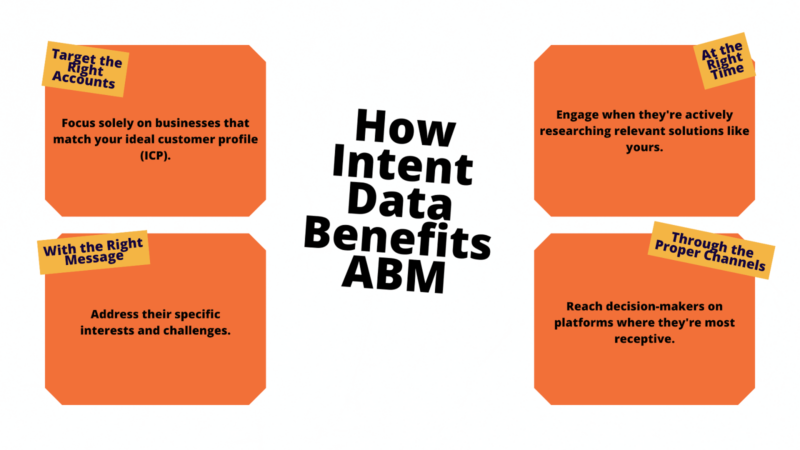Intent Data for ABM: Identify and Win Key Accounts
Description
Modern ABM strategies must go beyond identifying your ideal accounts and targeting them. Marketers can use quality data to better identify and engage high-potential accounts.
This is where intent data becomes the secret weapon in your ABM arsenal. Intent data transforms your ABM strategy from educated guesswork into precision targeting.
It does so by revealing which accounts are actively researching solutions like yours. Intent data helps you focus your resources on prospects most likely to convert, personalize your messaging to address their specific needs, and time your outreach for maximum impact.
In this comprehensive guide, we’ll explore how to leverage intent data for ABM and drive measurable business results.
Key Takeaways
- Intent data reveals which accounts are actively researching solutions like yours, allowing you to prioritize prospects most likely to convert.
- Combining first-party and third-party intent signals creates a comprehensive view of account behavior and buying readiness.
- Effective ABM strategies leverage intent data to personalize outreach, align sales and marketing efforts, and time interventions precisely.
- Intent-driven ABM campaigns can reduce sales cycles by up to 30% and significantly increase conversion rates.
- Implementing intent data requires the right tools, transparent processes, and ongoing optimization to maximize your return on investment (ROI).
TABLE OF CONTENTS:
- What Is Intent Data and Why Does It Matter for ABM?
- Types of Intent Data for ABM
- How to Use Intent Data in Your ABM Strategy
- Implementing Intent Data in Your ABM Program: A Step-by-Step Guide
- Real-World Success: Intent Data ABM Case Studies
- Challenges and Best Practices
- The Future of Intent Data in ABM
What Is Intent Data and Why Does It Matter for ABM?
Intent data is a type of market intelligence that informs marketers of how accounts research products. It identifies the content that accounts consume, identifying any challenges or solutions they’re searching for.

Marketers can collect intent data through various first and third-party sources. When layered into your ABM strategy, intent data creates the perfect storm of targeting precision:
- Target the right accounts: Focus solely on businesses that match your ideal customer profile (ICP).
- At the right time: Engage when they’re actively researching relevant solutions like yours.
- With the right message: Address their specific interests and challenges.
- Through the proper channels: Reach decision-makers on platforms where they’re most receptive.
Approximately 98% of organizations currently use or plan to use ABM as a strategic tactic. At the core of each successful campaign is understanding the intent of your ideal buyer.
Types of Intent Data for ABM
To effectively leverage intent data in your ABM strategy, it’s essential to understand the different types available and how each contributes to your targeting efforts.
First-Party Intent Data
This is data you collect directly from your digital properties, including:
- Website visit patterns (pages viewed, time spent).
- Email engagement (opens, clicks).
- Content downloads (whitepapers, ebooks).
- Form submissions.
- Product usage metrics.
- Customer support interactions.
First-party data is highly valuable because it represents direct engagement with your brand. These individuals are already familiar with your offerings and are actively showing interest. Marketers will better understand their customer journey and can identify the accounts that are more likely to convert.
Third-Party Intent Data
Third-party data offers a broader view of your target audience. This is collected by external data aggregators across many websites and digital properties, then sold as a service. Examples include:
- Technographic data (such as from your technology stack).
- Search queries across the web.
- Content consumption across multiple publications.
- Social media post engagement.
- Forum and community participation.
Third-party data helps you identify accounts that show interest in your solution category, even if they haven’t visited your website yet. While third-party data may not be up-to-date or accurate, it can still provide valuable insights into your sales funnel and lead progression.
Behavioral Intent Data
This focuses on online activities in the customer journey that signal buying intent. Here are ways to collect behavioral intent data:
- Pricing page visits
- Competitor comparison research
- Multiple product demo views
- Sales-related content consumption (ROI calculators, buying guides)
- Multiple visits in a short timeframe
Contextual Intent Data
This examines the context surrounding engagement to determine the level of intent. Marketers can extract contextual intent data from:
- Content topic relevance
- Content consumption patterns
- Device and location patterns
- Time-of-day engagement patterns
- Seasonal or event-triggered research
Declared/Zero-Party Intent Data
This is information directly s





